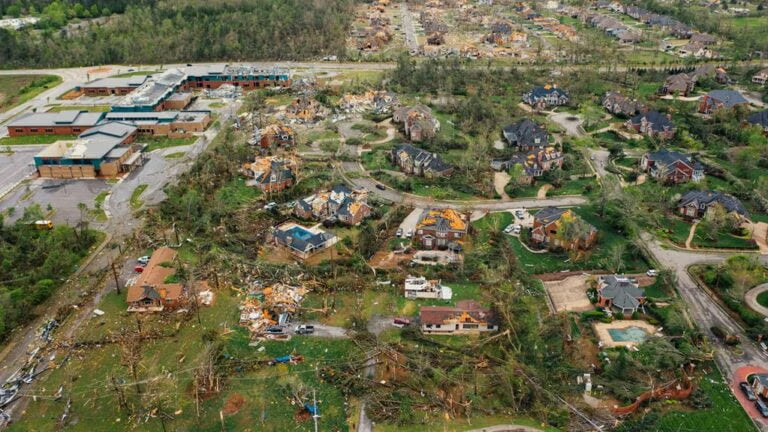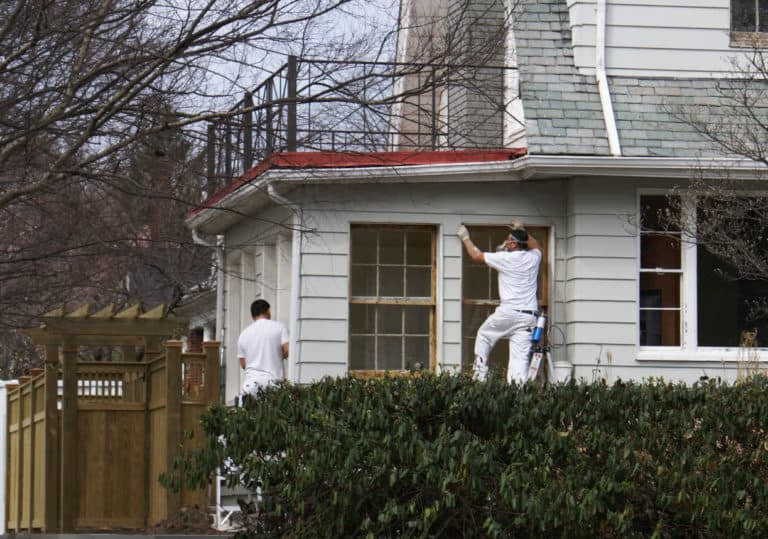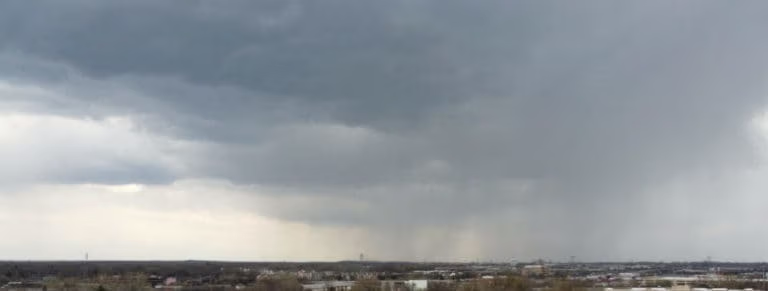I've been there, staring up at a growing water stain on my ceiling, feeling helpless. First, identify the leak's source by inspecting your attic and roof for water stains or damaged shingles. Move valuable items to safety and contain the water with buckets and towels. For temporary relief, use a tarp or roof patching tape. Document everything for insurance claims – photos are vital. Call a roofing professional to ensure the leak is properly fixed and prevent future issues. Regular inspections and maintaining gutters will also help. Ready to tackle a roof leak like a pro? There's more you should know.
Navigating Roof Leaks: Effective Strategies
- Identify the Leak Source: Inspect the ceiling, attic, and roof to locate where the leak originates.
- Protect Valuable Items: Move electronics, documents, and keepsakes to a dry area and cover furniture with waterproof covers.
- Contain the Water: Use buckets and towels to capture leaking water and prevent further damage.
- Temporary Leak Fix: Apply a tarp, roof patching tape, or roofing cement to temporarily seal the leak.
- Document the Damage: Take detailed photos of the affected areas for insurance purposes and future repairs.
Identify the Leak Source
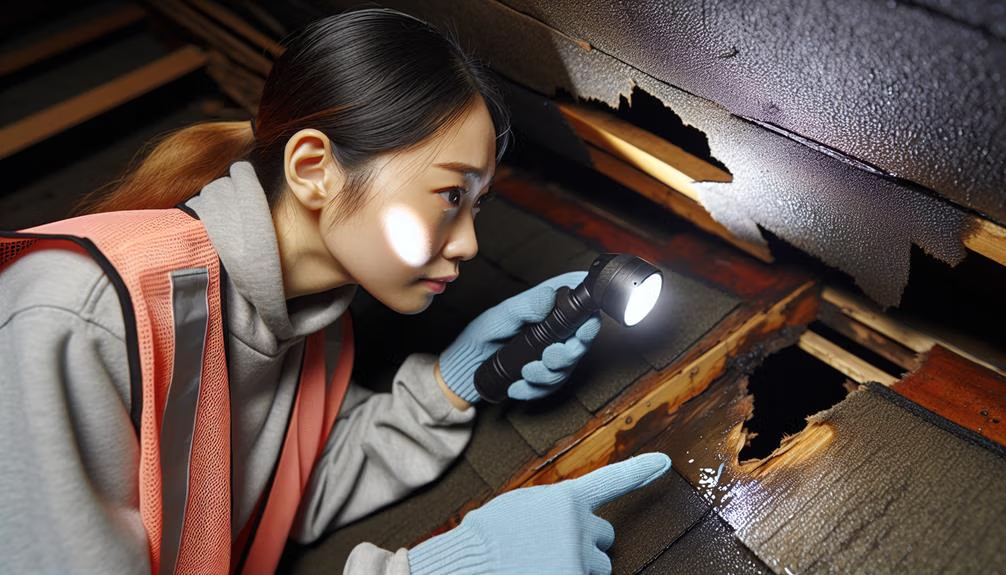
Pinpointing the origin of a roof leak often demands a meticulous inspection, as water can travel far from the initial entry point. The journey to find the source can feel daunting, much like searching for a needle in a haystack. I remember a particularly rainy evening when I discovered a damp patch on my living room ceiling. Initially, I thought the leak was directly above the spot, but after a detailed inspection, I realized the water had traveled along a beam from a completely different area of the roof.
A structured approach is essential. Begin by examining the interior ceiling for water stains or bubbling paint. These signs often provide the first clues. Next, ascend to the attic with a flashlight. Look for damp insulation, water stains on the wood, or even small trickles of water. Don't forget to inspect the roof from the outside, paying close attention to damaged shingles, compromised flashing, or clogged gutters.
This methodical approach not only identifies the leak's origin but also prevents future damage. The emotional relief of locating and addressing the issue is profound, transforming a stressful ordeal into a manageable repair task.
Move Items to Safety
When I discovered a leak in my roof last winter, my first instinct was to protect my valuables and relocate my electronics to avoid any potential damage. Acting swiftly, I covered important items with waterproof covers and ensured that any electronic devices were moved to a dry, safe location. It's crucial to act quickly to prevent further loss and safeguard your possessions during such unexpected incidents.
Protect Valuable Items
Swiftly relocating your valuable belongings to a safe, dry area can prevent further damage and preserve their condition. The moment you identify a roof leak, prioritize moving essential items such as electronics, important documents, and irreplaceable keepsakes. I remember the sense of relief I felt when I managed to save my grandmother's heirloom quilt from a sudden leak. This quick action can make a significant difference in minimizing loss and emotional distress.
Here's a practical guide to help you decide what to move first:
| Priority Level | Item Category | Examples |
|---|---|---|
| High | Electronics | Laptops, TVs, Mobile Phones |
| Medium | Documents | Passports, Birth Certificates |
| Low | Keepsakes | Photo Albums, Jewelry, Artwork |
Each item's priority can vary depending on its value and sentimental importance. For instance, during an unexpected leak, my first instinct was to rescue my laptop, containing years of work and personal projects. By prioritizing high-value and irreplaceable items, you can effectively mitigate damage and ensure a smoother recovery process. Remember, the key is to act quickly and decisively.
Use Waterproof Covers
As you move your valuable items to safety, consider using waterproof covers to provide an additional layer of protection against potential water damage. This simple step can be crucial in preserving the integrity of cherished possessions, especially in the chaos that often accompanies a leaky roof emergency.
I remember the panic when an unexpected storm turned my living room into a small pond. My antique wooden chest, passed down through generations, was in immediate danger. Grabbing a waterproof cover, I swiftly wrapped it around the chest. That quick decision saved not only the wood from swelling but also preserved its historical value.
Waterproof covers are readily available in various sizes. They can shield furniture, artwork, and other significant items from moisture. By using these covers, you create a barrier that helps mitigate the risk of damage until professional repair can be conducted.
Prioritize the most valuable and sensitive items first. For instance, photographs, important documents, and family heirlooms should be safeguarded immediately. This proactive measure not only ensures the safety of your possessions but also provides peace of mind during a stressful situation. Remember, a few moments of preparation can save years' worth of memories.
Relocate Electronics Quickly
In the midst of a roof leak, prioritizing the relocation of electronics can prevent further damage and potential hazards. The sight of water dripping from the ceiling can be overwhelming, but acting swiftly to move your valuable electronics is crucial. I recall vividly the time our living room ceiling began to leak after a heavy storm. My first instinct was to protect our electronics, and it made all the difference.
- Unplug and Move: Immediately unplug all electronics near the leakage area to avoid electrical shock or short circuits.
- Cover with Plastic: If relocation is not feasible, cover devices with plastic sheets to shield them from water.
- Elevate Off the Floor: Place electronics on higher surfaces or use waterproof containers to prevent water damage from pooling on the floor.
- Dry Immediately: Use towels or absorbent materials to dry any affected electronics as soon as possible.
Taking these steps not only safeguards expensive gadgets but also mitigates the risk of fire or electrical hazards. It's a small effort that can save you from significant losses and headaches down the line.
Contain the Water

When my roof leaked last winter, the urgency to contain the water was immediate. Using buckets and towels to capture the drips, I safeguarded my grandmother's cherished quilt and other valuables. Additionally, relieving the pressure on the ceiling by puncturing sagging areas prevented further damage.
Use Buckets and Towels
To quickly mitigate the damage caused by a leaking roof, strategically place buckets and towels to catch and absorb the water. This immediate action can prevent further harm to your home while you arrange for a more permanent solution. I remember one rainy evening when my living room ceiling began to drip relentlessly. The sound of each drop hitting the floor was nerve-wracking, but quick thinking saved the day.
Here are some practical steps to follow:
- Locate the Leak: Identify the exact spot where the water is entering. This will allow you to place the bucket directly under the leak.
- Use Multiple Buckets: If the leak is extensive, use multiple buckets to cover a larger area. This will help manage the water more efficiently.
- Lay Down Towels: Surround the buckets with towels to absorb any splashes or overflows. Towels can also be used to direct water towards the buckets.
- Check Frequently: Periodically empty the buckets and replace soaked towels to ensure they continue to function effectively.
These steps not only offer immediate relief but also bring a sense of control in an otherwise chaotic situation.
Protect Valuable Items
While managing the immediate flow of water with buckets and towels, it's equally important to protect your valuable items from potential water damage. I remember the anxiety I felt when a sudden storm caused a leak in my living room. My first instinct was to rush and save my grandmother's antique clock, a cherished family heirloom.
Start by relocating any valuable items, such as electronics, important documents, and sentimental belongings, to a dry and safe area. Use plastic bins or waterproof storage containers if available. For larger items like furniture, cover them with plastic sheets or tarps to prevent water from seeping in. I recall using an old shower curtain to shield my bookshelf, which housed my treasured collection of first-edition novels.
Additionally, elevate items off the floor if possible, especially if the leak is severe. Place books, photo albums, or electronics on higher shelves or atop sturdy furniture. In my experience, even a few inches can make a significant difference in preventing water damage.
Taking these proactive steps not only safeguards your possessions but also provides peace of mind during the chaos of a leaking roof. Remember, swift action is crucial to minimize potential losses.
Relieve Ceiling Pressure
Occasionally, the sheer weight of accumulated water can cause a sagging ceiling, posing a significant risk of structural damage and potential injury. Addressing this immediately is crucial. Once, during a storm, I ignored a small leak in our living room. The ceiling began to bulge, and the potential for catastrophic damage became alarmingly real.
To manage this, you can follow these steps:
- Pierce the bulge: Using a screwdriver or similar tool, create a small hole at the center of the sagging area. This controlled puncture allows the water to drain, preventing a sudden collapse.
- Prepare a container: Before piercing, place a bucket or large container directly beneath the bulge to catch the draining water and minimize further damage.
- Distribute the pressure: If multiple bulges are present, pierce each one slowly to evenly distribute the pressure and prevent any section from bearing excessive weight.
- Inspect regularly: After relieving the initial pressure, keep an eye on the ceiling for any additional sagging or new leaks.
Temporary Leak Fix
When confronted with a sudden roof leak, a temporary fix can offer immediate relief and prevent further damage until professional repairs can be arranged. The torrential downpour last summer had me scrambling for a solution as water streamed into my living room. I remember rushing to the attic, armed with a bucket and a tarp, my heart racing with every drop that hit the floor.
The first step in a temporary fix is to locate the source of the leak. This can be challenging, especially during heavy rain, but even a small clue, like water stains or dripping, can guide you. Once identified, use a tarp to cover the affected area. Secure it tightly with nails or heavy objects to ensure it stays in place despite wind or rain.
Another quick fix involves roof patching tape or roofing cement. These materials can provide a temporary seal, buying you precious time. For those without these supplies on hand, even heavy-duty garbage bags or plastic sheeting can serve as a makeshift barrier against the elements.
My temporary fixes that day kept the damage from escalating, giving me peace of mind until help arrived.
Document the Damage
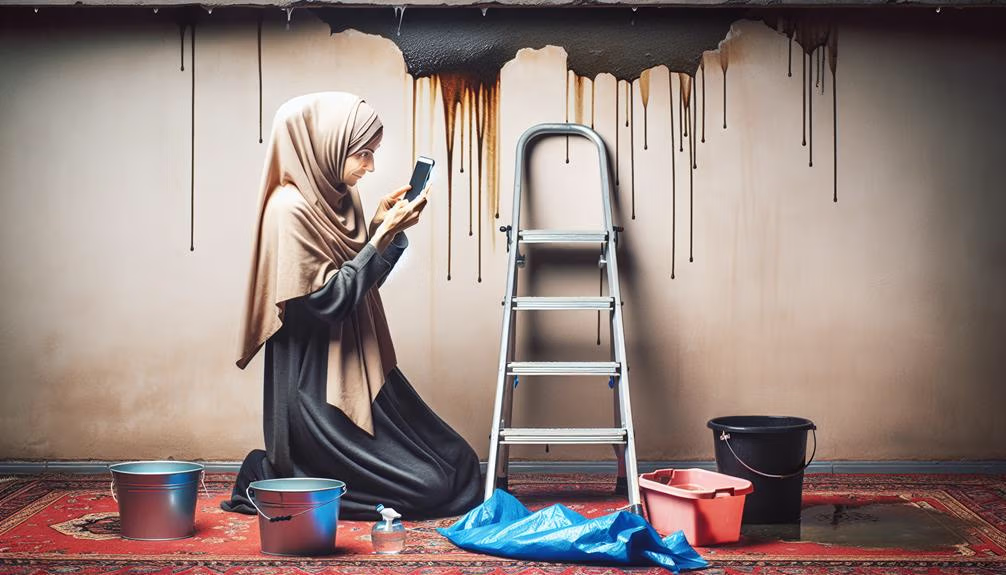
When facing the distress of a leaking roof, it's crucial to capture detailed photographs of the affected areas for insurance purposes. Note the exact source of the leak, as this information will be vital for repairs. Additionally, recording estimates from contractors can help you make informed decisions and expedite the repair process.
Photograph the Affected Areas
As soon as you notice a roof leak, promptly documenting the damage with clear photographs is crucial for both insurance claims and repair assessments. Capturing comprehensive images can help ensure that every detail is accounted for, from the smallest water stain to extensive drywall damage. When my roof began to leak during a storm last year, I found myself overwhelmed, but following these steps helped me stay organized and supported my insurance claim effectively.
To capture thorough documentation, consider the following guidelines:
- Wide Shots: Take wide-angle photos of the entire room to give context to the damage. This will help demonstrate the extent and location of the leak.
- Close-Ups: Snap close-up images of visible damage, such as water stains, mold growth, or peeling paint. This can help in identifying the severity of the leak.
- Different Angles: Photograph the same area from multiple angles. This approach provides a comprehensive view and can highlight details that might otherwise be missed.
- Timestamped Photos: Use a camera or a phone that records the date and time. These timestamps are essential for evidence, especially when filing insurance claims.
These steps not only provide an invaluable visual record but also serve as a crucial tool in the repair process.
Note the Leak Source
Identifying the precise source of the roof leak is a critical step, as it not only helps pinpoint the problem but also guides effective repairs and prevents future damage. My own experience with a persistent leak taught me the value of this step. I recall a rainy night when water dripped through the ceiling, and I felt a pang of helplessness. However, systematically tracking the water's path led to the revelation that the source was a damaged flashing around a skylight, not the roof's surface as I initially thought.
Once you locate the source, document the damage thoroughly. This involves noting the exact location, size, and severity of the leak. This information is invaluable for repair professionals and insurance claims.
Here's a useful table format to document your findings:
| Feature | Description | Notes |
|---|---|---|
| Location | Near skylight, north side | Visible water stains |
| Severity | Moderate | Steady drip during heavy rain |
| Damage Type | Flashing wear and tear | Rust and gaps observed |
| Immediate Actions | Placed a bucket, called a roofer | Scheduled inspection for tomorrow |
Documentation not only aids in repairs but also serves as a reminder of the urgency to address roof leaks promptly.
Record Repair Estimates
Securing detailed repair estimates is a crucial next step after documenting the damage, as it provides a clearer picture of the financial implications and helps you prioritize necessary actions. I remember when our roof began leaking during a torrential downpour; the immediate panic was overwhelming. However, obtaining well-documented repair estimates brought a sense of control and clarity amidst the crisis.
By reaching out to multiple contractors and comparing their quotes, you can make informed decisions that fit your budget and needs. Here are some key actions to consider:
- Gather Multiple Quotes: Contact at least three reputable contractors to get a range of repair costs.
- Ensure Detailed Breakdown: Each estimate should include labor, materials, and any additional costs to avoid surprises.
- Check References and Reviews: Ensure the contractors have a history of reliable work by reading reviews or speaking with previous clients.
- Assess Timing and Availability: Consider the contractor's availability and estimated completion time, especially if the damage is severe.
These steps not only help in securing the best possible deal but also instill confidence that the repairs will be handled professionally and promptly. The peace of mind that comes from a well-documented plan is invaluable during such stressful times.
Check for Mold
When dealing with a roof leak, it is crucial to check for mold promptly, as it can pose serious health risks and further damage your home. Mold thrives in damp environments, and a leaking roof creates the perfect breeding ground. The presence of mold can lead to respiratory issues, allergic reactions, and even more severe health problems if left unchecked.
I recall a time when my own home had a minor roof leak that we initially overlooked. Within weeks, we noticed a musty smell and dark spots on the ceiling. The emotional stress of discovering mold was overwhelming, knowing the potential harm it could cause my family and the additional repair costs we would face.
Here's a quick guide to help you identify common signs of mold and its potential impact:
| Signs of Mold | Potential Impact |
|---|---|
| Musty odor | Respiratory issues |
| Dark spots on ceilings/walls | Structural damage |
| Increased allergy symptoms | Health deterioration |
Inspect the Attic
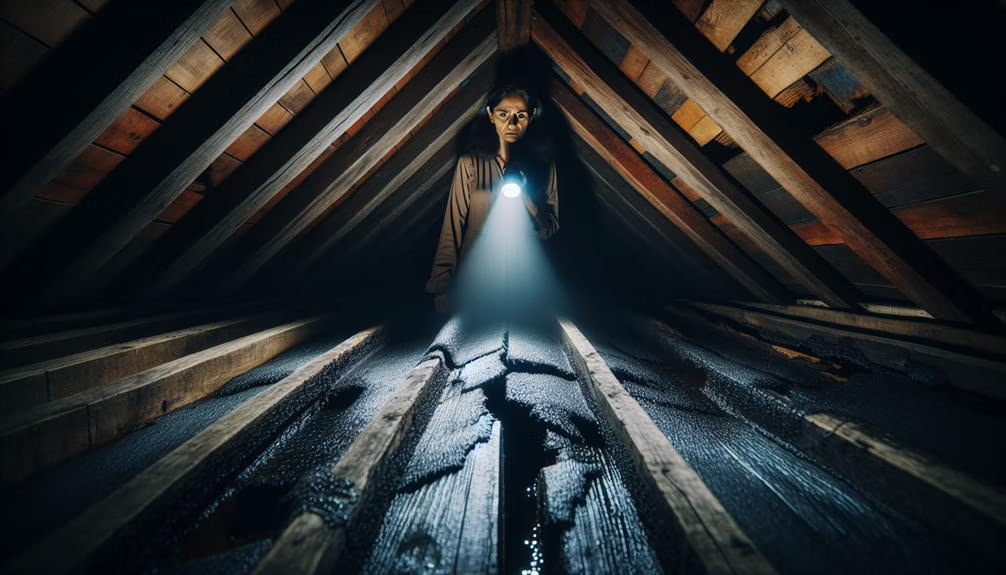
After addressing any mold issues, the next step is to inspect the attic to understand the extent of the roof leak. This critical part of the process can reveal hidden damages and help you pinpoint the source of the problem. I remember my own experience when we first noticed water spots on our ceiling; climbing up into the attic was a daunting task. Amid the dusty rafters and insulation, the reality of the damage became all too clear.
To make your inspection thorough and effective, consider the following key areas:
- Water Stains: Look for discoloration on the wooden beams and insulation, indicating the path of the leak.
- Wet Insulation: Damp or soggy insulation often points directly to where water is infiltrating.
- Daylight Through Roof: Any spots where daylight is peeking through indicate holes or significant gaps in the roofing material.
- Mold and Mildew: Even if mold wasn't visible in the living spaces, check for any signs of mold growth in the attic, as it can spread quickly in dark, damp environments.
Conducting a detailed attic inspection not only uncovers immediate issues but also helps prevent future complications, providing peace of mind as you address the leak.
Call a Roofing Professional
Engaging a qualified roofing professional is essential to ensure the leak is accurately diagnosed and effectively repaired. When my own home faced a roof leak last winter, I initially attempted a DIY fix, only to find the problem reoccurring with the next heavy rain. Calling a professional was the turning point that saved my home from further damage and stress.
A roofing expert brings years of experience and specialized tools, offering a thorough inspection to pinpoint the exact cause of the leak. They can identify hidden issues like weakened structures or compromised seals that aren't apparent to the untrained eye. This precision not only resolves the immediate problem but also prevents future leaks, safeguarding your home and peace of mind.
Furthermore, professionals adhere to safety standards that protect both your property and the workers. I remember how reassuring it was to see the team using safety harnesses and protective gear, knowing they were taking every precaution.
In addition to their technical prowess, reputable roofing companies often provide warranties for their work. This added layer of security ensures that if any issues arise post-repair, they will be addressed without additional cost, giving homeowners like us invaluable peace of mind.
File an Insurance Claim

Filing an insurance claim can be a daunting yet crucial step in mitigating the financial burden of a roof leak. I remember the overwhelming sense of relief when, after discovering extensive water damage in my attic, my insurance company came through. This process, though intricate, can be navigated more smoothly with the right approach.
First and foremost, promptly notify your insurance provider. This ensures the claim process begins without delay. Document every detail of the damage thoroughly. Take clear photographs and notes, which will be vital during the assessment.
Here's a simple breakdown to guide you:
- Notify Your Insurance Provider: Initiate the claim process immediately.
- Document the Damage: Capture detailed photos and notes of the affected areas.
- Temporary Repairs: Undertake necessary repairs to prevent further damage, but keep receipts.
- Assessment and Estimates: Meet with the adjuster and gather repair estimates.
I recall how stressful it was to deal with the insurance paperwork, but being organized helped immensely. Keeping a detailed log of every conversation and document streamlined the process. Remember, persistence is key. Your diligence can make a significant difference in the success of your claim and the restoration of your home.
Prevent Future Leaks
Addressing the immediate damage is only part of the solution; to truly safeguard your home, it's important to take proactive measures to prevent future leaks. My own experience taught me this valuable lesson. After the chaos of a sudden storm left a puddle in our living room, I knew we needed a long-term strategy.
First, schedule regular inspections. A professional can identify vulnerabilities that aren't visible to the untrained eye. I now have an annual checkup every autumn. This simple habit has saved me countless headaches.
Second, ensure proper attic ventilation. A well-ventilated attic prevents moisture buildup, reducing the risk of leaks. After consulting an expert, we installed additional vents, and the difference has been remarkable.
Third, maintain your gutters. Clogged gutters can lead to water pooling on your roof, seeping through the tiniest cracks. I make it a point to clear them every spring and fall, a small task that offers immense peace of mind.
Frequently Asked Questions
Can a Roof Leak Affect My Home's Electrical Wiring?
Absolutely, a roof leak can significantly impact your home's electrical wiring. I recall a time when a minor leak caused water to seep into our attic, damaging the insulation around the wires. It led to short circuits and a need for extensive repairs. Water and electricity are a perilous combination, potentially causing hazards like fires or electrical shocks. It's imperative to address roof leaks promptly to avoid such risks.
How Can I Prevent Roof Leaks During Heavy Rainfall?
Imagine a fortress standing strong against relentless storms. To ensure your roof remains such a fortress during heavy rainfall, regular maintenance is key. Clean gutters and downspouts to prevent water buildup. Inspect and repair damaged shingles or flashing. My own home once faced a torrential downpour, but with these measures, not a single drop breached our sanctuary. Stay proactive, and your roof will shield you from nature's fury.
What Materials Are Best for a Long-Lasting Roof Repair?
For a long-lasting roof repair, materials like asphalt shingles, metal roofing, and synthetic slate are highly recommended. Asphalt shingles are affordable and durable, while metal roofing offers exceptional longevity and resistance to harsh weather. Synthetic slate provides the aesthetic appeal of natural slate without the high cost and weight. Reflecting on my experience, opting for quality materials has saved me countless headaches and expenses over the years.
Are Roof Leaks Common in Older Homes?
Did you know that nearly 40% of older homes experience roof leaks? This issue is particularly prevalent due to aging materials and structural wear. As an owner of a charming 1920s bungalow, I've witnessed firsthand how critical timely maintenance is. Regular inspections and quality repairs can significantly extend the life of your roof and preserve the integrity of your beloved home.
How Do Seasonal Changes Impact Roof Integrity?
Seasonal changes profoundly affect roof integrity. Winter's freeze-thaw cycles can cause shingles to crack, while summer's intense heat can lead to warping. Spring brings heavy rains that test waterproofing, and fall's falling leaves can clog gutters, causing water damage. Personally, I recall a particularly harsh winter when ice dams formed on my roof, leading to leaks and costly repairs. It's crucial to perform regular maintenance to mitigate these impacts.
Conclusion
Ironically, the uninvited guest known as a roof leak demands immediate and strategic action, turning homeowners into impromptu crisis managers. Identifying the leak source, safeguarding belongings, and containing the water become paramount. Temporary fixes and thorough documentation precede professional intervention and insurance claims. The attic inspection, often overlooked, reveals hidden damage. Despite the exhaustive efforts, only proactive maintenance can secure a leak-free future, underscoring the paradox of prevention as the ultimate remedy to reactive haste.

